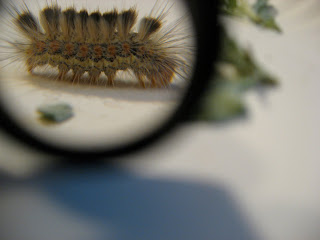I found this millipede crossing my path. When I picked it up, it rolled into this protective coil. This millipede has the adaptation of strong armor like panel segments on its back so it is hard yet flexible. Because of the smallness of segments it can instantly coil to protect its many legs and vulnerable underside.
Barrel cactus ready to bloom. Many cacti are pollinated by moths.
This sparrow nest was spotted by Lynn as she was looking for caterpillars. The nest is well protected at the heart of an ocotillo, which has extremely sharp inch long spines camouflaged in those soft fluttery leaves. These spines are the plant's adaptation to protect itself and many desert birds take advantage of this spiny desert plant's adaptation. Can you think of other adaptations of plants that benefit other species?
Completely satisfied, even though I was sweaty, covered with tiny biting blackflies and out of water, we loaded our ice chest with at least fifteen different species and host plant matter to bring back to our zoo.
Back at the lab I was able to take a closer look at two arctiideas I found.
Angela Smilanich, of University of Nevada and Desert Research Institute, explained to me that these two are the same species of arctiidae. The one with the black tufts is a 5th instar and the fatter one on bottom is a third instar. An instar is a larval stage. When a caterpillar hatches, it is in its first instar. Each time it molts, sheds its skin, it changes to the next instar. Caterpillars have 5 instars before they pupate. (And yes, this is the one with the spiny hairs that probably stuck in my skin.)







No comments:
Post a Comment